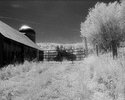&c &c
the
paper safe can be used to store
exposed film until you are ready to develop
print tongs are used to save your fingers, gloves not necessary
these are the best I have seen, easily pick up print stuck to bottom of tray, don't scratch or slip
AVOID the
BAMBOO with
RUBBER print tongs
they soak up chemicals
IF your camera does not leave the leader out, you may need a leader retriever to pull it out
once the leader is out, cut the end off square, then start loading the plastic reel. Do not
worry, as there is about 3" of skipped film before the first picture.
NOW turn off the lights and finish loading the reel.
Once the reel is loaded, cut off the film from the cartridge and finish loading the reel
put the reel on the center tube, then put in the tank, then screw on the lid.
REALITY CHECK is the lid on good, check it, if so, Turn On The Light
if you honestly can NOT load one of those easy load reels without looking, there is one option,
the
kodak day-load tank
the 12 page manual is
www.darkroompro.com/pdf/misc_equipment/kodak_dl.pdf
read it, it describes everything to do step by step with pictures
NO safelights are to be used during loading of pan film
ORTHO film may be handled with RED safelight, such as
Kodak 10 Dark Amber
ORTHO film is not sensitive to RED light, check the datasheet for actual sensitivity range
a DARK GREEN safelight may be used to inspect the development process, probably more trouble
than it's worth
________________________________________________
the only time you need to measure is when preparing the developer [chemicals]
there is more than 1,000 developers, the key is to find some you like
some developers you may want to try are cited in patents 2,757,091 % 3,772,019 % 4,083,722 % 4,363,869
reading and using patent descriptions is a good way to experiment
the later patents are very long in describing how and why something works
the .xls document I created compares chemicals and developers [attached]
this chart lists some of kodak's film developers
as you can see, there is no perfect developer
some reasons why d-76 is used so much
1. it started as a motion picutre film that was created using knowledge of chemsitry
2. it worked so well that others made their own version
3. it still works for just about any B/W film
4. with 80+ year track record, people trust it
for more info on d-76 and similar developers
http://silvergrain.org/Photo-Tech/d-76.html
id-11 is similar to d-76 in chemistry and development times, but there are variations in times
that may make a difference, SFX has the biggest difference of 1 1/2 minutes when dev. for 800 speed in stock solution
Ilford has cross reference tables for their and competitor's products located
here
the only
necessary chemicals are
developer and
fixer
develop "soup" of the day
stop not absolutely necessary, prolongs life of fixer
rinse not absolutely necessary, prolongs life of fixer
fix do not cut short fixing times, treat as developer
wash plain water
wash
wash
drying agent brief soak to aid in drying without water marks
recommended practice is to
AVOID times
less than 5 minutes, due to possibility of uneven development
it is usually best to develop at 20c or 24c
elevated temps usually require a different formula










 no more getting
no more getting  because the film won't load after you realize the reel was backwards and would never load
because the film won't load after you realize the reel was backwards and would never load 

















